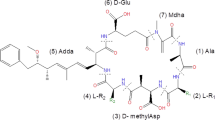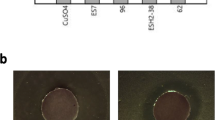Abstract
Purpose
As the most common variant of microcystins (MCs), microcystin-LR (MCLR) is a kind of toxins produced by some species of harmful cyanobacteria and more and more attention has been paid to it. Biodegradation has been extensively investigated and recognized to be a cost-efficient and environmentally benign method for MC clean-up. In order to further research the growth characteristics of strain and the biodegradation characteristics of MCLR, it is necessary to use the dynamic mathematical models as powerful and useful tools.
Methods
In this study, strain CQ5 was screened and identified by morphological observation, physiological and biochemical tests, and 16S rDNA sequence analysis. The kinetic models of cell growth and MCLR degradation were established with the Gompertz model and revised Monod kinetic model.
Results
The results showed that strain CQ5 had the closest phylogenetic similarity to Lysinibacillus boronitolerans (T-10a, AB199591) in the phylogenetic tree, with 99% bootstrap support. Strain CQ5 could utilize MCLR as the carbon and nitrogen source for growth. When the initial pH value was 7 and the inoculation amount was 3%, strain CQ5 grew well in MSM, in which the MCLR crude extract was used as the carbon and nitrogen source of strain CQ5. Within 244 h, the MCLR concentration changed from 14.12 to 1.57 μg/L and its degradation rate could reach 88.88%. The growth curve fitted with the Gompertz growth model (Nt = 1.3119 * exp(−0.1237 * exp(−6.6341t)), R2 > 0.99). The process of MCLR degradation agreed with the first-order reaction kinetic equation (lnS = 2.64764 − 0.01537t, R2 > 0.99). The linkage relationship between MCLR concentration, cell density, and MCLR degradation rate was consistent with the revised Monod equation (V = 0.342S, R2 > 0.97) at low substrate concentration, where Vmax/ Ks was 0.342. The dynamic relationship in which strain CQ5 degraded MCLR and used it as the carbon and nitrogen source to promote its own growth could be explained by the equation S = 14.12 e− 0.342 Nt (N = 1.08).
Conclusion
The growth of strain CQ5 and MCLR concentration in degradation system could be simulated and predicted by the dynamic mathematical models in this study. And the predicted results were very consistent. These results could provide theoretical reference for studying the mechanism of MCLR biodegradation and promote the engineering application of strain CQ5.






Similar content being viewed by others
References
Black JG (2012) Microbiology principles and explorations, 8th edn. Wiley
Bourne DG, Riddles P, Jones GJ, Smith W, Blakeley RL (2010) Characterisation of a gene cluster involved in bacterial degradation of the cyanobacterial toxin microcystin LR. Environ Toxicol 16(6):523–534
Chen LM, Chai LH (2005) Mathematical model and mechanisms for biofilm wastewater treatment system. World J Microbiol Biotechnol 21(8–9):1455–1460
Chen LM, Chai LH (2006) A theoretical analysis on self-organized formation of microbial biofilms. PHYSICA A 370(2):793–807
Chen ZH, Dong XN, Shen HC, Chen D, Mao LQ, Zhang WY (2018) Study on screening and characteristics of algal-toxin degradation bacteria in reed the bottom mud of reed marshes from Lake Taihu. Ind Saf and Environ Prot (in Chinese) 44(5):29–32
Dziga D, Wasylewski M, Wladyka B, Nybom S, Meriluoto J (2013) Microbial degradation of microcystins. Chem Res Toxicol 26(6):841–852
Edwards C, Graham D, Fowler N, Lawton LA (2008) Biodegradation of microcystins and nodularin in freshwaters. Chemosphere 73(8):1315–1321
Eleuterio L, Batista JR (2010) Biodegradation studies and sequencing of microcystin-LR degrading bacteria isolated from a drinking water biofilter and a fresh water lake. Toxicon 55(8):1434–1442
Guo XC, Lu SY, Xie P, Chen J, Liu XH (2016) Environmental exposure, toxicity and toxic mechanism of microcystins: a review. Asian J Ecotoxicol (in Chinese) 11(3):61–65
Hall T, Hart J, Croll B, Gregory R (2007) Laboratory-scale investigations of algal toxin removal by water treatment. Water Environ J 14(2):143–149
Ho L, Hoefel D, Saint CP, Newcombe G (2007) Isolation and identification of a novel microcystin-degrading bacterium from a biological sand filter. Water Res 41(20):4685–4695
Ho L, Sawade E, Newcombe G (2012) Biological treatment options for cyanobacteria metabolite removal - a review. Water Res 46(5):1536–1540
Jia JP, He XQ, Jin Y (2009) Statistics (the 4th edition). China Renmin University Press
Lam AK, Fedorak PM, Prepas EE (1995) Biotransformation of the cyanobacterial hepatotoxin microcystin-LR, as determined by HPLC and protein phosphatase bioassay. Environ Sci Technol 29(1):242–246
Leyva-Díaz JC, Poyatos JM, Barghini P, Gorrasi S, Fenice M (2017) Kinetic modeling of Shewanella baltica KB30 growth on different substrates through respirometry. Microb Cell Factories 16:189–199
Li H, Pan G (2014) Enhanced and continued degradation of microcystins using microorganisms obtained through natural media. J Microbiol Methods 96(1):73–80
Li J, Peng L, Li J, Qiao Y (2014) Divergent responses of functional gene expression to various nutrient conditions during microcystin-LR biodegradation by Novosphingobium sp. THN1 strain. Bioresour Technol 156(2):335–341
Lin RC (1986) Research on the re-pollution of organic materials and the kinetics of organic material removal in biological wastewater treatment. J Tianjin Univ (in Chinese) 1:28–31
Manage PM, Edwards C, Singh BK, Lawton LA (2009) Isolation and identification of novel microcystin-degrading bacteria. Appl Environ Microbiol 75(21):6924–6928
Mu LN, Chen CW, Yu SZ, Liu JL, Wu YY, Zhu WC (2000) Investigation study on the content of microcystin in Tai Lake and methods for microcystin treatment. Chinese J Public Health (in Chinese) 16(9):803–806
Oliveira CS, Ordaz A, Ferreira EC, Alves M, Thalasso F (2011) In situ pulse respirometric methods for the estimation of kinetic and stoichiometric parameters in aerobic microbial communities. Biochem Eng J (58-59):12–19
Ou YXR, Zhao QH, Wei YZ (2013) A preliminary exploration of dissolved oxygen based on FVCOM in Meiliang Bay, Lake Taihu and its influence mechanism. J Lake Sci (in Chinese) 25(4):478–488
Ramani A, Rein K, Shetty KG, Jayachandran K (2012) Microbial degradation of microcystin in Florida’s freshwaters. Biodegradation 23(1):35–45
Rao LR, Li QY, Fan PC (2011) A method for extracting microcystin-LR from the cyanobacteria in Lake Taihu. CN102153635A
Rastogi RP, Sinha RP, Incharoensakdi A (2014) The cyanotoxin-microcystins: current overview. Rev Environ Sci Biotechnol 13(2):215–249
Rongsayamanont C, Limpiyakorn T, Law B, Khan E (2010) Relationship between respirometric activity and community of entrapped nitrifying bacteria: implications for partial nitrification. Enzym Microb Technol 46:229–236
Shimizu K, Maseda H, Okano K, Itayama T, Kawauchi Y, Chen R, Utsumi M, Zhang Z, Sugiura N (2011) How microcystin-degrading bacteria express microcystin degradation activity. Lakes Reserv Res Manag 16(3):169–178
Song H, Reichwaldt ES, Ghadouani A (2014) Contribution of sediments in the removal of microcystin-LR from water. Toxicon 83(2):84–90
Spanjers H, Takacs I, Brouwer H (1999) Direct parameter extraction from respirograms for wastewater and biomass characterization. Water Sci Technol 39(4):137–145
Vareli K, Jaeger W, Touka A, Frillingos S, Briasoulis E, Sainis I (2013) Hepatotoxic seafood poisoning (HSP) due to microcystins: a threat from the ocean? Mar Drugs 11(8):2751–2768
Wang JB, Chai LH, Zhang Y (2013) Substrate-revised Monod equation-a new model on microorganism growth. Adv Microbiol 2:49–52
Wang FF, Wu Y, Gao Y, Chen ZL (2014) Biodegradation of microcystin-LR by Burkholderia Vietnamiensis. Chin J Environ Eng 8(9):3837–3840
Wu YH, Kerr PG, Hu ZY, Yang LZ (2010) Removal of cyanobacterial bloom from a biopond-wetland system and the associated response of zoobenthic diversity. Bioresour Technol 101(11):3903–3908
Xie W, Wu J, Li YC, He XW, Du Y, Wang GY (2012) Screening and identification of microcystins degrading bacterial strain. J Biol (in Chinese) 29(6):35–38
Yan H, Wang HS, Liu XL, Yin CH, Xu QQ, Lu L, Ma WB (2014) Advances in the pathway and molecular mechanism for the biodegradation of microcystins. Environ Sci (in Chinese) 35(3):1205–1208
Yang JD, Yin YF, Hu LB, Zhou W, Ding HR, Shi ZQ, Yan SH (2009) Biodegradation of microcystins by indigenous mixed bacterial population JSM004. J Agro-Environ Sci (in Chinese) 28(8):1669–1672
Yang F, Zhou Y, Sun R, Wei H, Li Y, Yin L, Pu Y (2014) Biodegradation of microcystin-LR and-RR by a novel microcystin-degrading bacterium isolated from Lake Taihu. Biodegradation 25(3):447–457
You DJ, Chen XG, Xiang HY, Ou YL, Yang B (2014) Isolation, identification and characterization of a microcystin-degrading bacterium Paucibacter sp. strain CH. Environ Sci (in Chinese) 35(1):313–316
Zhang XH (2001) Principles and applications of higher environmental chemistry and microbiology. Chemical Industry Press, Beijing
Zhang J, Zheng Y, Li CY, Chai LH (2011) A confined DLA model of microbial biofilm in wastewater treatment systems. International Conference on Electrical and Control Engineering (ICECE), Yichang (16-18): 4234–4237
Zhao JB, Liu KY, Xue G, Cheng QY, Liu YN (2012) Research of screening and degradation characterstics of bacterium for the degradation of microcystins-LR. Chin J Environ Eng 6(2):671–674
Zhao S, Chen W, Jia YL, Zheng LL, Zuo YX, Song LR (2013) Characteristics of microcystin-degrading bacterium isolation from sedimentation ponds for the treatment of cyanobacterial blooms. Acta Hydrob Sinica 37(3):522–525
Zhu XY, Shen YT, Chen XG, Hu YOO, Xiang HY, Tao J, Ling Y (2016) Biodegradation mechanism of microcystin-LR by a novel isolate of rhizobium sp. TH and the evolutionary origin of the mlrA gene. Int Biodeterior Biodegrad 115:17–25
Funding
This work was supported by the National Natural Science Foundation (No. 41571471), the Jiangsu Science and Technology Support Project (No. BE2016653), and the Major Science and Technology Projects for Water Pollution Control and Treatment (2017ZX07202-003/004).
Author information
Authors and Affiliations
Corresponding author
Ethics declarations
Conflict of interest
The authors declare that they have no conflict of interest.
Research involving human participants and/or animals
This article does not contain any studies with human or animal subjects.
Informed consent
Informed consent is not required in this study.
Additional information
Publisher’s note
Springer Nature remains neutral with regard to jurisdictional claims in published maps and institutional affiliations.
Rights and permissions
About this article
Cite this article
Shen, R., Chen, Z., Dong, X. et al. Biodegradation kinetics of microcystins-LR crude extract by Lysinibacillus boronitolerans strain CQ5. Ann Microbiol 69, 1259–1266 (2019). https://doi.org/10.1007/s13213-019-01510-6
Received:
Accepted:
Published:
Issue Date:
DOI: https://doi.org/10.1007/s13213-019-01510-6




